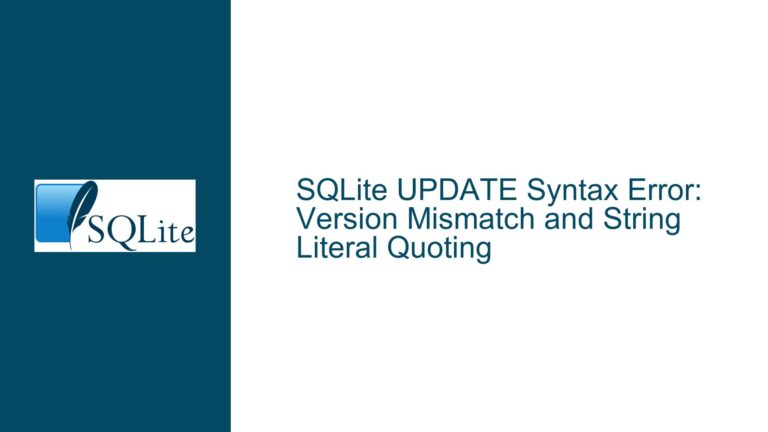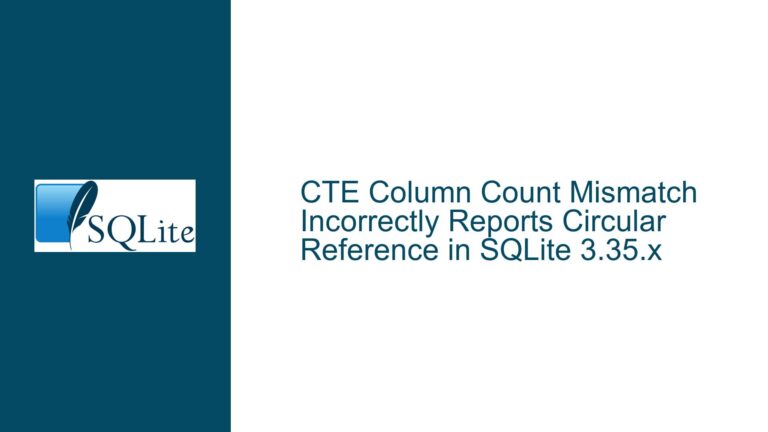SQLite ID Validation and PHP Integration Issues
SQLite ID Validation Logic and PHP Code Errors
The core issue revolves around validating the existence of a specific ID in an SQLite database using PHP. The user aims to create a web application that checks if an ID passed via a URL parameter exists in the database. If the ID exists, the application should allow editing of the corresponding entry; otherwise, it should display an error message. The provided PHP code contains several critical errors, including logical flaws, SQL injection vulnerabilities, and inefficient database handling.
The primary problem lies in the PHP script’s logic for checking the existence of an ID. The script attempts to fetch a record from the monsterinfo table using the ID provided in the URL parameter. However, the logic is flawed due to the misuse of the assignment operator (=) instead of the equality operator (==) in the conditional statement. Additionally, the script opens the database connection twice, which is redundant and inefficient. The code also lacks proper error handling and sanitization of user inputs, making it vulnerable to SQL injection attacks.
Misuse of Assignment Operator and SQL Injection Vulnerabilities
The misuse of the assignment operator (=) in the conditional statement is a significant issue. In PHP, the assignment operator assigns a value to a variable, whereas the equality operator (==) checks if two values are equal. The script incorrectly uses the assignment operator, which always evaluates to true, leading to incorrect validation logic. This flaw causes the script to always display the "ID exists" message, regardless of whether the ID is present in the database.
Another critical issue is the lack of input sanitization, which exposes the script to SQL injection attacks. The script directly incorporates the $_GET['id'] parameter into the SQL query without any validation or escaping. This allows an attacker to inject malicious SQL code into the query, potentially compromising the database. For example, an attacker could manipulate the id parameter to execute arbitrary SQL commands, such as deleting records or extracting sensitive information.
The script also opens the database connection twice, which is unnecessary and inefficient. Each call to new SQLite3("./db/MonsterDB.db") creates a new connection to the database, consuming additional resources. This redundancy can be avoided by reusing the existing database connection throughout the script.
Correcting Validation Logic and Securing the PHP Script
To address these issues, the script must be revised to use the equality operator (==) for proper ID validation. The corrected conditional statement should compare the id field from the database with the $_GET['id'] parameter using the equality operator. This ensures that the script accurately determines whether the ID exists in the database.
To prevent SQL injection, the script should use prepared statements with bound parameters. Prepared statements separate SQL code from user input, preventing attackers from injecting malicious SQL. The SQLite3Stmt class in PHP provides a secure way to execute parameterized queries. By binding the $_GET['id'] parameter to a placeholder in the SQL query, the script ensures that the input is treated as a literal value rather than executable code.
The script should also be optimized to use a single database connection. Instead of opening the connection twice, the script should reuse the initial connection for all database operations. This reduces resource consumption and improves performance.
Here is the corrected and optimized PHP script:
<?php
// Open the database connection
$db = new SQLite3("./db/MonsterDB.db");
// Check if the ID parameter is set and is a valid integer
if (isset($_GET['id']) && ctype_digit($_GET['id'])) {
$id = intval($_GET['id']);
// Prepare the SQL query with a placeholder for the ID
$stmt = $db->prepare("SELECT * FROM monsterinfo WHERE id = :id");
$stmt->bindValue(':id', $id, SQLITE3_INTEGER);
// Execute the query and fetch the result
$res = $stmt->execute();
$dsatz = $res->fetchArray(SQLITE3_ASSOC);
// Check if the ID exists in the database
if ($dsatz) {
echo "ID " . htmlspecialchars($id) . " exists";
// Display the edit form
echo '<div style="border: 1px solid #ccc; width:850px; padding: 15px 15px; margin-left: 10px;">';
echo '<table class="admin_overview_a">';
echo '<tr><td>Monster in bearbeitung: ' . htmlspecialchars($dsatz["number"]) . ' ' . htmlspecialchars($dsatz["name"]) . '</td></tr>';
echo '<tr><td colspan="2" width="380"> </td></tr>';
echo '<form>';
echo '<tr><td width="80" class="admin_overview_c">ID:</td><td width="300"><input type="text" value="' . htmlspecialchars($dsatz["id"]) . '"></td></tr>';
echo '<tr><td width="80" class="admin_overview_c">Nummer: </td><td width="300"><input type="text" value="' . htmlspecialchars($dsatz["number"]) . '"></td></tr>';
echo '<tr><td width="80" class="admin_overview_c">Name: </td><td width="300"><input type="text" value="' . htmlspecialchars($dsatz["name"]) . '"></td></tr>';
echo '<tr><td width="80" class="admin_overview_c">Name: </td><td width="300"><input type="text" value="' . htmlspecialchars($dsatz["name2"]) . '"></td></tr>';
echo '<tr><td width="80" class="admin_overview_c">Name: </td><td width="300"><input type="text" value="' . htmlspecialchars($dsatz["name3"]) . '"></td></tr>';
echo '<tr><td> </td></tr>';
echo '<tr><td><input type="button" value="speicher"></td></tr>';
echo '</form>';
echo '</table>';
echo '</div>';
} else {
echo "ID " . htmlspecialchars($id) . " does not exist";
}
} else {
echo "Invalid ID parameter";
}
// Close the database connection
$db->close();
?>
This revised script addresses the logical errors, secures the application against SQL injection, and optimizes database handling. It uses prepared statements to safely incorporate user input into SQL queries and reuses the database connection to improve efficiency. Additionally, the script includes basic input validation to ensure that the id parameter is a valid integer before processing it. These changes make the script more robust, secure, and efficient.






